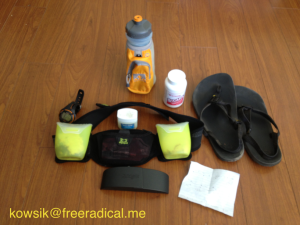After running seven races so far, I would not necessarily call myself an experienced runner, but one does learn a thing or two and start watching out for patterns that seem to work every time. And then there are things that can be improved upon each run. My race day running checklist is something that I started a couple of months ago and have been tweaking it ever since. I start going over the checklist the night before the race and the ritual continues on in the morning and then through the race.
Race Day Running Checklist
Probably the biggest rule for me is nothing new on race day. This includes the brand of Vaseline, my running shorts and t-shirt, the hydration pack and so on. Everything has to be broken in and tried a few times before it comes with me on race day. The night before the race, I do spend a fair bit of time pouring over the course map, the elevation chart and the location of the aid stations. In fact, in the recent past, I’ve been making a hand-drawn map of the elevation chart with the aid-stations situated at the various mile markers. Even during the race, I find this map extremely helpful to break down the distance into shorter manageable goals. Like for example, I’ll mentally note that the next aid station is 6 miles away, which means I’ll probably be running for 50 minutes or so. And then it’s up or down and so on.
Here’s a list of my race day running checklist and what I use them for:
- My Luna Sandals, of course, ‘cos that’s what I run with. I also make it a point to not race with a brand new pair of Lunas that’ve just arrived. Typical rule of thumb is at least a couple of weeks of breaking in over multiple 10+ mile runs.
- During winter, I also carry a pair of gloves, my Split Toe Tabi socks and a head band that covers my ears. Staying warm makes the run that much more fun.
- I usually wear glasses and I find it much more enjoyable to run with contact lenses. However, I bring my glasses with me and leave them in the car, just in case. I know, like tripping, falling and losing a contact. Hasn’t happened yet, but still…
- For hydration I’m still experimenting, but the last month I’ve been running with a Nathan hand-held 22oz bottle that comes with an ID card and a phone holder. I love taking pictures during the run. Great way to remember the trails I’ve been on.
- I use an Amphipod with two snap-in food containers. I typically pack three corn tortillas, spread Amy’s refried beans on them, add olives, roll them and half them. In addition to the sugariness of the Clif Shots at aid stations, I find real food to be a nice refreshing treat while on the run.
- As I mentioned above, I stick a hand-drawn map of the elevation chart and the aid station mile markers in my running shorts that I like to consult when I get to an aid-station. Gives me a great “what’s next” perspective of the race.
- After getting calf cramps in the last couple of races, I’ve been experimenting with Succeed Caps and I take one every hour with generous amounts of water. Still early and unproven, but it seems to keep my calves from cramping.
- I think chaffing (especially my inner thighs) is inevitable when your runs are longer than 15 miles. I tried Body Glide, but found generous amounts of Vaseline to be just as effective and cheap.
- My Timex watch (comes with a Heart Rate Monitor, that I don’t seem to use much) is primarily useful to keep track of hydration and fueling cycles and eyeballing splits. I am not very paranoid about my splits and try to mostly enjoy the race without killing myself. One thing that I do try and do is every 15 minutes, take a gulp of water and then swap hands so one arm doesn’t get sore after a long run.
- This is trivial, but if the park requires a parking fees, having the exact change when I’m still grumpy and groggy in the morning when I get there helps quite a bit.
Not on the material top 10, but I think it’s important to bring your smile and positive attitude to the run. And a little small talk + a thank you to all the volunteers at every aid station only makes the run that much more meaningful. I feel it’s critical to stop, take in the view and break into a smile, when I get to some vista point in a trail run. Isn’t that one of the awesome reasons for running so hard and climbing up crazy hills?
What’s your race day running checklist? Anything else you would add to this?
[sc:follow_me ]